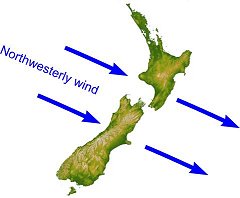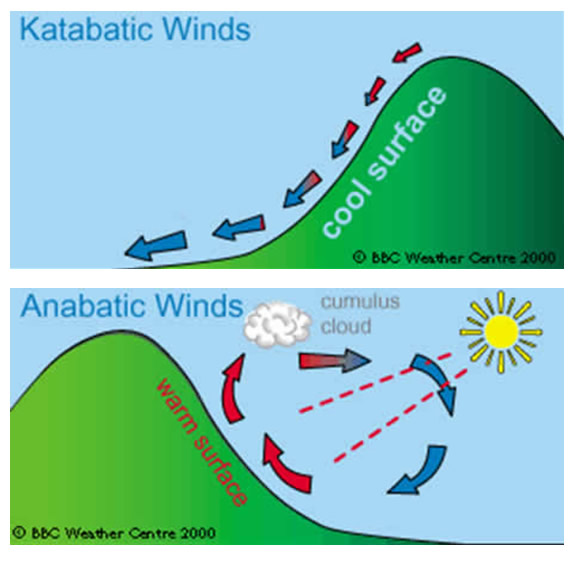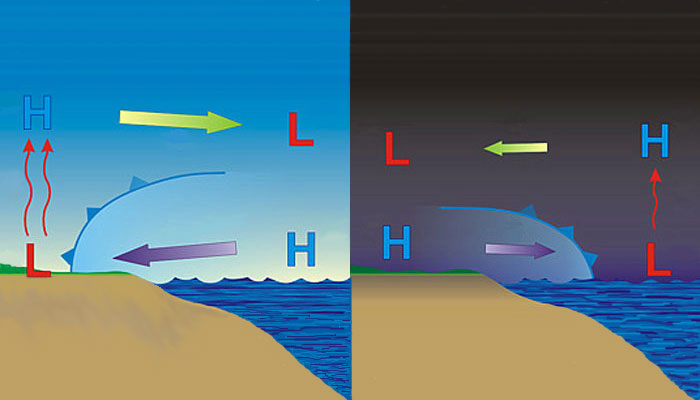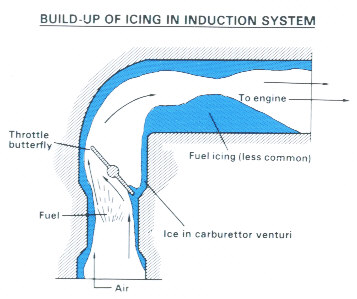Describe the flight conditions associated with Fohn wind conditions.
Very warm conditions and turbulence can at times be moderate to severe at low levels, posing a risk to light aircraft operations especially during landing and takeoff phases.
Describe the flight conditions associated with Fohn wind conditions.
Very warm conditions and turbulence can at times be moderate to severe at low levels, posing a risk to light aircraft operations especially during landing and takeoff phases.
Given environment temperatures, Dew points and mountain heights, determine the: a) cloud base on the windward side; b) cloud base on the lee side; c) temperature at stated datum level on the lee side.
a) The moisture content of the rising air is retained on the windward side in the form of rain and cloud drops, sticking to trees and rocks.
b) When air at the mountain top starts its descent on the lee side, it only needs to go down to 2000 ft in order to warm to the new Dew point. This means the cloud base on the lee side is high.
c) Air on the lee side of a mountain is much warmer that the windward side; due to loss of moisture it is so much drier.


Describe the Fohn wind process.
Fohn wind process is when warm dry air is blown off the Swiss Alps (eg also the Canterbury Norwester)
Development of a Fohn wind requires the following
– substantial mountain range
– a wind blowing at right angles to the mountains
– a high moisture content of the approaching air

Describe the katabatic and anabatic wind processes, and state the: a) typical timing of the occurrence; b) average strength of the winds; c) effect of moist valley air on cloud/fog formation; d) effect of gravity on Katabatic winds; e) effect of adiabatic cooling and warming.
Katabatic wind is a wind which descends at certain times in mountainous terrain.
Anabatic winds go upwards; ie opposite to a katabatic wind
Katabatic winds are essentially a night time phenomenon, sometimes going into the morning
Anabatic winds are associated with warm air rising after sunrise, with warming through conduction
When the valley floor and parts of the sloping walls go into shadow towards the end of the day, air touching the cold walls cools through a process of conduction. This leads to an increase in density of the affected air, so it will sink and draw adjacent air down with it.
When the cold air settles at the valley floor it can enhance the development of fog.
Colder air is denser than warmer air and thus will tend to sink

Describe the effect of local obstructions on wind flows
A local low-level obstruction to a strong surface flow will create tumbling and turbulence downstream from the object
Immediately downwind the air will be dumping toward the ground creating a localised down- draught
The turbulent area created by an object in the air flow extends to twice the height of the object vertically and 15 times the height of the object horizontally before steady frictional flow is re-established
Describe the land breeze process, and state: a) typical timing of the occurrence; b) average speed of the wind; c) most likely season for the occurrence.
This wind is the reverse of the sea breeze – ie it blows from the land to the sea
a) When the land cools from evening onwards, the sea remains relatively warm, sea air tends to rise and replacement air flows from the land to sea.
b) Land breeze is rarely more than 3-4 knots
c) In the autumn the sea is still warm after a long summer, but the land starts to experience the occasional early frost, making this season the most likely for land breezes to occur.
Describe the sea breeze process, including typical: a) timing of the occurrence; b) average strength of the sea breeze; c) horizontal and vertical limits; d) associated cloud development; e) associated turbulence.
As the land warms more quickly than the sea, air over land warms rapidly after sunrise and becomes less dense; whereas air over the sea retains it’s cooler temperature.
At a given height the pressure over the land is greater than the pressure over the sea causing air to travel from the land to the sea. As a result of this transfer of mass the surface pressure over the land reduces and increases over the sea causing the surface wind to blow from the sea to the land.
a) Most of the time the sea breeze sets in around 10 am, peaks in strength at 3 pm and ceases before sunset.
These times can vary somewhat in tropical regions where sea breeze can persevere after sunset.
b) The strength of the sea breeze depends mainly on the difference in temperature of the land and the sea, but under normal circumstances it averages around 10-15 knots.
This is greater in springtime when the sea is still rather cold and the land starts to experience some high temperatures.
A greater temperature difference between the land and the sea normally produces a stronger sea breeze and vice versa
c) Sea breezes usually penetrate inland about 25 – 40 km and reach a height of about 2-3000 ft.
This depends to a large degree on terrain inland.
Eg Southern Alps may block inland travel of the breeze on the West Coast
d) It is common for cumulus cloud to develop after the sea breeze has begun.
Often referred to as Fair Weather Cumulus, it has a base of 2000 ft and tops another 1-2000 ft, sometimes showers may result.
When the prevailing wind is from the land to the sea, the sea breeze quite often forces itself inland underneath this wind and wind shear is present at the top of the sea breeze, where it borders on the prevailing (opposing) wind.
e) Interference from sand dunes, hills, steep cliffs and tree plantations on the sea breeze can cause turbulence – especially at low levels eg after taking off or approaching to land.

Explain the conditions that can cause carburettor icing while on the ground.
Carburettor icing can occur on the ground as well as during flight – mainly during taxiing
This causes rough running and a loss of power; and in some severe cases can stop the engine running.
Ideal condtitions for this are:
– wet surface such as after rain when evaporation makes the surface very moist
– taxiing close to mudflats or near the coast where the layer of air near the surface has high moisture content especially in light winds
– taxiing in rain
– taxiing over a frosty surface after sunrise
When on the ground at idle power settings, carburettor icing is a serious problem. With the throttle closed, the risk of
ice jamming the butterfly shut is high, especially if the aircraft is parked for an extended period while a novice pilot
works slowly through the pre-take-of checks. For this reason, we apply carburettor heat to melt any ice prior to
take-off.
Carburettor heat is unfiltered warm air extracted from around the exhaust system. This heated air is less dense than
the ambient air, and so there will be a noticeable drop in RPM when carb heat is applied. But being unfiltered means
there is a risk of introducing dust and seeds etc. into the carburettor and engine. These not only cause wear and tear
on the engine but may ultimately lead to an engine failure after take-of. Aircraft which are used frequently from
grass strips should be kept clean in the engine bay to avoid exacerbating this potential problem.
Explain how the accretion rate of carburettor ice is influenced by the throttle setting.
When the throttle is reduced the gaps between the Venturi wall and throttle butterfly become smaller with the result that carburettor ice near those gaps is likely to accrete faster

State the temperature range in which carburettor ice typically can form.
Carburettor icing will likely form in the temperature range +25 degrees C and -10 C to -15 degrees C
Depends on the moisture content; which means carb icing is a possibility on a hot summers day.
